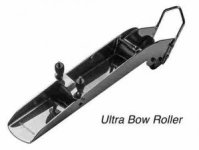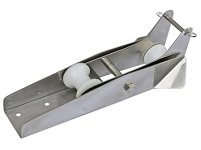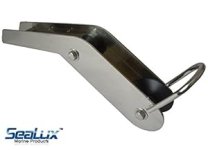tparrent
New member
- Joined
- Dec 23, 2009
- Messages
- 285
- Reaction score
- 0
- C Dory Year
- 2017
- C Dory Model
- 255 Tomcat
- Vessel Name
- Tomfoolery
Another beautiful day in North Carolina today with cool morning temperatures, light winds and a cloudless sky. Since I'd figured out the windlass situation - and had my spare anchor in hand - I figured it was the perfect time to take my ten year old son and his friend out for a float.
At the launch ramp, I tested the windlass. Seemed fine.
Started the engine. No problem.
Powered up the chartplotter. Um...
Powered up the chartplotter. Dagnabbit. Nothing.
Who needs a chartplotter on local waters? Not me! I powered away from the dock and off for some more (mis)adventures.
I quickly realized I had no power to anything other than the windlass and engine. Hmmmm...
I motored over to the nearest quiet cove and anchored. I decided that troubleshooting on the open lake was not a good idea. Anchoring went fine without a hitch - except for the usual need to reach through the hatch and give the anchor a shove to make it ready to fall. At least it's not putting any pressure on the windlass sitting there pointing to the sky.
I pressed the "Push to Reset" button on the control panel. Pressing didn't work so I got literal and "pushed" it. Same non-result. Of course, now that I am an experienced electrical troubleshooter, I went in search of a bigger, badder breaker and I found it back by the engine, buried under dock lines in the starboard locker. The black on black color scheme couldn't fool me this time and I felt around until I found the tripped switch and reset it. Megawatts of power all over the boat!
I know that I should figure out what is causing these circuit breakers to trip but not while I have two ten year olds aboard. We motored off in search of adventure.
My boat guy told me he had not filled the tanks before I launched but I knew I had five gallons in the starboard tank because I had not used any during the last misadventure. I had a few drops left in the port tank, which I was drawing from, so what could go wrong?
I switched to the starboard tank, which has never actually had fuel drawn successfully from it, and continued down the lake. Five minutes later the engine started coughing. I pumped the priming bulb and could feel fuel but it wasn't real high pressure. I switched back to the port tank and used up some more of my precious drops of fuel getting to another cove where I anchored again.
This time I left the engine running and switch to the starboard tank again. I squeezed the primer bulb for quite awhile and the engine kept purring away. Looks like I had solved that problem - although I did wonder why I had never had to touch the priming bulb when using the port tank - even when I started the season with all new fuel in both tanks.
I pondered this while the engine continued to purr. The boat guy had replaced ALL the fuel lines a month ago after he found the starboard pickup line had actually rotted away - never having been used. No matter, the engine was working now.
Upon retrieving the anchor, the windlass started acting up again when it got to the rope chain link. I had not had this problem the last few times out but prior to that it often failed to pull the rode through the link. I had to work it back and forth quite a bit before it finally pulled everything in. The Lewmar instructions clearly state you can use a rope/chain rode and, of course, they recommend their own rode - which I had installed. It's a very annoying problem, especially when conditions are not as calm as today.
The engine had been idling a good twenty minutes before we once again got underway. Five minutes later the engine quit - right on the busiest part of the lake. I switched back to the port tank and, without any priming at all, the engine started right up. Odd.
I very slowly made it back to the ramp on my remaining fumes, puzzled at what could be going wrong.
So now I have three problems to sort through before I head down to the coast for some serious exploring in the next couple weeks:
1. What is causing the circuit breakers to trip?
2. How can I get the fuel feed from the starboard tank working?
3. Is there any adjustment I can make to the windlass to a) allow the anchor to self launch and b) retrieve all of the rode smoothly?
It's been years since I have boated regularly. I'd forgotten how much "fun" all this problem solving can be :crook
At the launch ramp, I tested the windlass. Seemed fine.
Started the engine. No problem.
Powered up the chartplotter. Um...
Powered up the chartplotter. Dagnabbit. Nothing.
Who needs a chartplotter on local waters? Not me! I powered away from the dock and off for some more (mis)adventures.
I quickly realized I had no power to anything other than the windlass and engine. Hmmmm...
I motored over to the nearest quiet cove and anchored. I decided that troubleshooting on the open lake was not a good idea. Anchoring went fine without a hitch - except for the usual need to reach through the hatch and give the anchor a shove to make it ready to fall. At least it's not putting any pressure on the windlass sitting there pointing to the sky.
I pressed the "Push to Reset" button on the control panel. Pressing didn't work so I got literal and "pushed" it. Same non-result. Of course, now that I am an experienced electrical troubleshooter, I went in search of a bigger, badder breaker and I found it back by the engine, buried under dock lines in the starboard locker. The black on black color scheme couldn't fool me this time and I felt around until I found the tripped switch and reset it. Megawatts of power all over the boat!
I know that I should figure out what is causing these circuit breakers to trip but not while I have two ten year olds aboard. We motored off in search of adventure.
My boat guy told me he had not filled the tanks before I launched but I knew I had five gallons in the starboard tank because I had not used any during the last misadventure. I had a few drops left in the port tank, which I was drawing from, so what could go wrong?
I switched to the starboard tank, which has never actually had fuel drawn successfully from it, and continued down the lake. Five minutes later the engine started coughing. I pumped the priming bulb and could feel fuel but it wasn't real high pressure. I switched back to the port tank and used up some more of my precious drops of fuel getting to another cove where I anchored again.
This time I left the engine running and switch to the starboard tank again. I squeezed the primer bulb for quite awhile and the engine kept purring away. Looks like I had solved that problem - although I did wonder why I had never had to touch the priming bulb when using the port tank - even when I started the season with all new fuel in both tanks.
I pondered this while the engine continued to purr. The boat guy had replaced ALL the fuel lines a month ago after he found the starboard pickup line had actually rotted away - never having been used. No matter, the engine was working now.
Upon retrieving the anchor, the windlass started acting up again when it got to the rope chain link. I had not had this problem the last few times out but prior to that it often failed to pull the rode through the link. I had to work it back and forth quite a bit before it finally pulled everything in. The Lewmar instructions clearly state you can use a rope/chain rode and, of course, they recommend their own rode - which I had installed. It's a very annoying problem, especially when conditions are not as calm as today.
The engine had been idling a good twenty minutes before we once again got underway. Five minutes later the engine quit - right on the busiest part of the lake. I switched back to the port tank and, without any priming at all, the engine started right up. Odd.
I very slowly made it back to the ramp on my remaining fumes, puzzled at what could be going wrong.
So now I have three problems to sort through before I head down to the coast for some serious exploring in the next couple weeks:
1. What is causing the circuit breakers to trip?
2. How can I get the fuel feed from the starboard tank working?
3. Is there any adjustment I can make to the windlass to a) allow the anchor to self launch and b) retrieve all of the rode smoothly?
It's been years since I have boated regularly. I'd forgotten how much "fun" all this problem solving can be :crook



